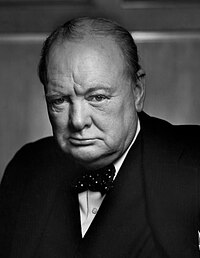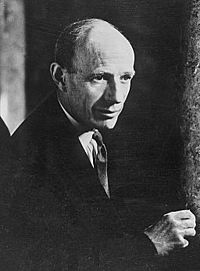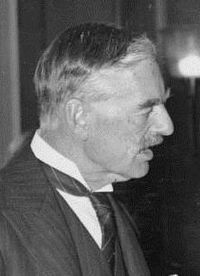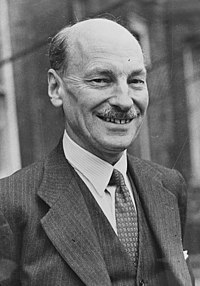Dunkirk and the British war cabinet
In late May 1940, as the Wehrmacht reached the English Channel and the British Expeditionary Force (BEF) retreated to the port of Dunkirk, tensions within the British war cabinet led to its members dividing over the question of whether to make terms with Nazi Germany or to continue hostilities. The main protagonists were the Prime Minister, Winston Churchill, and the Foreign Secretary, Lord Halifax. The dispute escalated to crisis point and threatened the continuity of the Churchill government. The retreat to Dunkirk signalled the imminent fall of France and Halifax believed the government should explore the possibility of a negotiated peace settlement. His hope was that Hitler's ally, the still-neutral Italian dictator Mussolini, would broker an agreement.
Churchill opposed negotiation and urged his colleagues to fight on. He was supported in the war cabinet by its two Labour members, Clement Attlee and Arthur Greenwood, and also by Sir Archibald Sinclair, who as leader of the Liberal Party was co-opted to the war cabinet for its meetings about proposed negotiations. Churchill's biggest problem was that he was not the leader of the Conservative Party and he needed to win the support of ex-Prime Minister Neville Chamberlain, without which he could have been forced to resign by the large Conservative majority in the House of Commons.
Background
Churchill becomes Prime Minister
The 1935 UK general election was the last until 1945. It resulted in a decisive victory for the multi-party group which formed the Third National Government (1935–1937). It principally consisted of the Conservative Party, and included the remaining members of the Liberal National Party and the National Labour Committee, as well as some independent MPs. Led by Stanley Baldwin, who became Prime Minister for the third time, the government held a substantial majority (more than 200) in the House of Commons.
In May 1937, Baldwin retired and was succeeded by Neville Chamberlain as leader of the Fourth National Government (1937–1940). Chamberlain continued Baldwin's foreign policy of appeasement in the face of German, Italian and Japanese militancy. Having signed the Munich Agreement with Hitler in 1938, Chamberlain became alarmed by the dictator's continuing aggression and, in August 1939, signed the Anglo-Polish military alliance which guaranteed British support for Poland if attacked by Germany. When Germany did invade Poland, Chamberlain issued a declaration of war on 3 September 1939 and formed a war cabinet which included Winston Churchill (who had been out of office since June 1929) as First Lord of the Admiralty and Lord Halifax as Secretary of State for Foreign and Commonwealth Affairs (Foreign Secretary).
Dissatisfaction with Chamberlain's leadership became widespread in the spring of 1940 after, having mounted Operation Weserübung, German forces invaded and occupied Norway. On 7–8 May, the House of Commons debated the Norwegian campaign, which had gone badly for the Allies. The Norway Debate quickly escalated into fierce criticism of the Conservative-led government's conduct of the entire war. At the end of the second day, the opposition Labour Party forced a division, which amounted to a motion of no confidence in Chamberlain's leadership. Chamberlain as Prime Minister was heavily criticised on both sides of the House by members expressing a strong desire for national unity. The Conservative rebels mostly wanted the formation of a true national government which would include the opposition Labour and Liberal parties; the Liberal Nationals having essentially become part of the Conservative Party at this point, an arrangement that would be formalised after the war ended, and the National Labour group having had minimal influence in the government since the death of former Prime Minister Ramsay MacDonald. Churchill made the closing speech in the Norway Debate and mounted a strong defence of Chamberlain, ending his speech with these words:[1]
At no time in the last war were we in greater peril than we are now, and I urge the House strongly to deal with these matters not in a precipitate vote, ill debated and on a widely discursive field, but in grave time and due time in accordance with the dignity of Parliament.
The government's notional majority was 213, but 41 members who normally supported the government voted with the Opposition, while an estimated 60 other Conservatives deliberately abstained. The government still won the vote by 281 to 200, but their majority was reduced to 81. This would normally be sustainable, but at a time of national crisis with Britain losing the war, it was a shattering blow for Chamberlain.
Next day, Thursday, 9 May, Chamberlain attempted to form a national coalition government. In talks at 10 Downing Street with Churchill and Halifax, Chamberlain indicated his willingness to resign if that was necessary for Labour to enter such a government. Labour leader Clement Attlee and his deputy Arthur Greenwood joined the meeting and, when asked if they would serve in a coalition, they said they must first consult their party's National Executive Committee, who were then in Bournemouth preparing for the annual party conference that was to start the following Monday. Even so, they indicated that it was unlikely they could serve in a government led by Chamberlain; they probably would be able to serve under another Conservative. They agreed to telephone on Friday afternoon with the result of their consultation.
Earlier on Thursday, Chamberlain had met Halifax alone and had tried to persuade him to be his successor. Halifax would probably have been the Conservative Party's preferred candidate. Halifax replied that, as a peer and not therefore a member of the Commons, he would be seriously disadvantaged as Prime Minister and would have to delegate direction of the war effort to Churchill in the Commons. He did not change his position when the same question arose at the evening meeting in which Chamberlain and Halifax were joined by Churchill and the party's Chief Whip, David Margesson. Churchill's own account of these events, written six years later, is not accurate. It describes the events of 9 May as taking place the following day, and the description of Chamberlain attempting to persuade him to agree tacitly to Halifax's appointment as Prime Minister does not tally with Halifax having expressed his reluctance to do so at the morning meeting with Chamberlain.
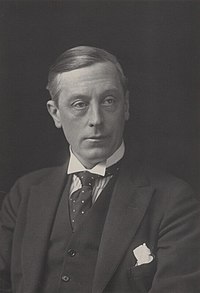
The Wehrmacht launched its blitzkrieg against western Europe on the morning of Friday, 10 May, by invading Belgium, Luxembourg and the Netherlands. Given this new crisis, Chamberlain at first declared that he would not resign, but he decided after all to await the Labour Party's decision, which he did not receive until late afternoon. Attlee telephoned Downing Street at about 4:45 pm to confirm that Labour would join a coalition government, but not under Chamberlain's leadership. Accordingly, Chamberlain went to Buckingham Palace, where he had an audience with King George VI at 6:00 pm. He tendered his resignation and, after the King asked him who should be his successor, recommended Churchill. The King sent for Churchill, who agreed to form a coalition government; the public announcement was made by Chamberlain on BBC Radio at 9:00 pm.
On Saturday, 11 May, the Labour Party agreed to join the national government under Churchill's leadership, and he was able to form his war cabinet which, at the outset, was restricted to five members, with himself as Prime Minister and Minister of Defence. Attlee relinquished his official role as Leader of the Opposition to become Lord Privy Seal (until 19 February 1942 when he was appointed Deputy Prime Minister) and Greenwood was appointed a Minister without Portfolio. The main problem for Churchill as he became Prime Minister was that he was not the leader of the Conservative Party, and so he was obliged to include Chamberlain in the war cabinet, as Lord President of the Council, and to retain Halifax as Foreign Secretary. The war cabinet was augmented by the three service ministers who attended most of its meetings; these were Churchill appointees on whose support he could generally rely. Conservative Anthony Eden became Secretary of State for War, Labour's A. V. Alexander succeeded Churchill as First Lord of the Admiralty and the leader of the Liberal Party, Sir Archibald Sinclair, became Secretary of State for Air.
War situation to Friday, 24 May
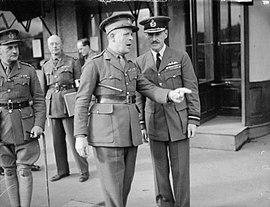
By 21 May, German tanks were approaching Boulogne-sur-Mer. In his diary entry that day, John Colville said preparations for the evacuation of the British Expeditionary Force (BEF) were being made in case of necessity.[2] An estimated 400,000 Allied servicemen, mostly of the BEF with elements of the French First Army, had retreated into the coastal area. Their hopes rested mostly on the success of the Weygand Plan, a proposed counter-offensive by themselves in conjunction with a strike from the south by the main French forces. This did not come to fruition and the BEF commander, Lord Gort, decided that evacuation was the only option. During 23 and 24 May, the Royal Navy evacuated an estimated 4,365 servicemen from Boulogne.
At a war cabinet meeting on the morning of Friday the 24th, Churchill reported that there were large numbers of French troops in Dunkirk but as yet no British servicemen other than a few specialist units. He had been advised that the port was functioning well with supplies being unloaded. There was a proposal to send Canadian troops to Dunkirk but this was pending developments in the wider theatre.
The war cabinet's interest in Italy on 24 May was limited to keeping it out of the war, or at least delaying its entry. Halifax presented a telegram from the French government which suggested an approach to the Italian dictator Mussolini by U.S. President Franklin D. Roosevelt, assuming he was willing to co-operate, for the purpose of enquiring what Mussolini's grievances were in order to have these discussed by all concerned before any resort to military action. Halifax was not confident that anything would come of the French idea but he said he would support it on condition that the approach was presented to Mussolini as a personal initiative by Roosevelt.
On the morning of 24 May, Hitler, having consulted General von Rundstedt, ordered the Panzers to halt their advance. This has been seen as one of the key decisions of the war as it gave the British extra time that they desperately needed to evacuate their servicemen from Dunkirk. Some of the German commanders disagreed with it and, a week later, General von Bock wrote in his diary that "when we do finally reach Dunkirk, the English will all be gone".[3]
Events of Saturday, 25 May
The war cabinet met in Downing Street at 11:30 am. Halifax confirmed that he had replied to the French government about their idea of persuading Roosevelt to approach Mussolini. Halifax also reported on a discussion between Sir Robert Vansittart and an unnamed Italian diplomat, although he understood the approach to be unofficial.
References
- ↑ Conduct of the War – Churchill. Hansard, House of Commons, 5th Series, vol. 360, col. 1362 (8 May 1940).
- ↑ Colville 1985, p. 159.
- ↑ Jenkins 2002, p. 598.
Provenance
- Some content on this page may previously have appeared on Wikipedia.
This work was originally written by me using pseudonyms and was published online 15 December 2019.
Some minor additions and amendments were made between 13 September 2020 and 18 January 2021. I think it should retain the attribution notice for the present and be classified as developing. Thanks. John (talk) 10:34, 31 May 2023 (CDT)
